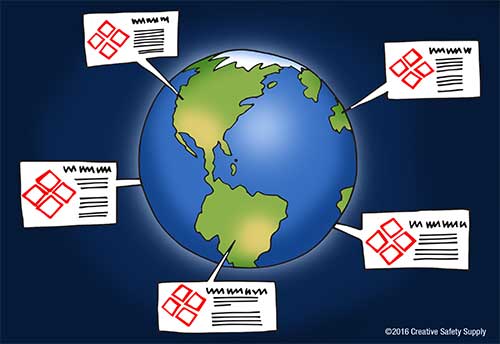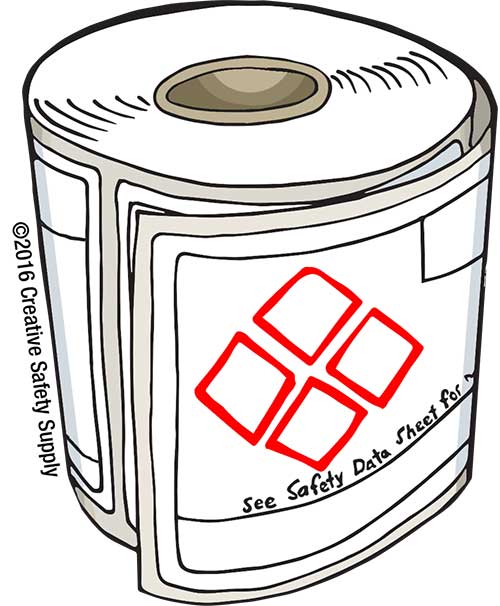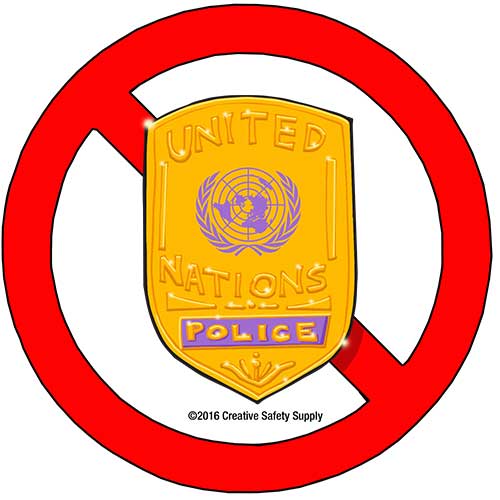The Globally Harmonized System, also known as GHS, is a standard that has been adopted by companies, governments, universities and other institutions around the world. Recently aligned with OSHA’s Hazard Communication Standard, the newly combined GHS and HCS system is focused on creating a consistent way of classifying chemical hazards. The improvements made to these standards also aim to reduce trade barriers to those who deal with these substances regularly.
This guide is not meant to replace any official training courses or compliance manuals. Instead, it will help give more of a high-level overview of what GHS is and its necessary compliance requirements.
What Does GHS Stand For?
The Globally Harmonized System of Classification and Labeling of Chemicals was initially created by the United Nations in 1992 to improve workplace safety. Since implementing this standard globally, miscommunications that often result in serious accidents have been much easier to avoid. Part of this is due to the fact that costly and error ridden re-labeling efforts are no longer needed when countries create and transport hazardous chemicals from one place to the next with this consistent labeling standard.

For most companies, GHS became important back on March 26, 2012 when OSHA published their final rule that revised the old Hazard Communication Standard to be in line with GHS. The update impacted millions of workers throughout a wide range of different workplaces on subjects such as the classification of hazards, GHS labeling requirements, safety data sheets, and employee training.
GHS and OSHA Standards
Today, GHS compliance is necessary for all facilities to avoid fines or other penalties from OSHA. OSHA requires every company that deals with hazardous chemicals to have a hazard communication program in place. This communication program includes several steps that build an effective and safe environment for employees, those include:
- Learning about the relevant standards
- Implementing a written hazard communication program
- Following GHS label requirements
- Maintaining SDSs
- Training employees
- Periodically reassessing the hazard communication program
GHS Training

Just like any other improvement strategy, if the employees don't understand or follow it, then it will be virtually useless. With this in mind, developing a good training program to help ensure everyone is on the same page is essential.
If onsite training is an option, make sure to use a reliable manual or GHS guide to ensure all the most important topics are covered. Once the bulk of training is completed for new hires the next step is to keep GHS standards on everyone’s minds. The following are some ideas on how this can be done:
- Follow up classes - Offering annual 'refresher' classes will help keep the information fresh.
- Updated handouts - Whenever there is an update to the GHS standards or how the facility uses them, make sure detailed explanations are given to employees.
- GHS posters - Putting up GHS posters throughout the facility is a great way to have constant visual reminders for those working in the area.
2019 Changes: GHS Revision 8
In July of 2019, the 8th revised edition of GHS was published. These new changes include:
- The classification criteria for aerosols. Under the new edition, aerosols will be classified in three categories for their hazard class. They are determined based on their flammable properties, heat of combustion, and applicable test results.
- A new hazard category. It is now possible to identify and classify chemicals under pressure, Information on criteria, as well as corresponding signal words, pictograms, and hazard statements, are provided.
- New labeling examples for sets or kits. There are now examples for set/kit labeling for situations in which there is not enough space to relate the required information.
- New precautionary pictograms. This edition includes two new pictograms developed by AISE and JSDA. The pictograms convey the meaning of precautionary statement P102: “Keep out of reach of children.”
- Other hazards not previously classified. An altered Annex 11 provides advice on dust explosion hazards. It covers potential factors, identification, mitigation, prevention, communication, and risk assessment.
- New skin corrosion/irritation classification. The new revision now includes detailed instructions on how to use in vitro/ex vivo test data to analyze whether a substance or mixture causes skin irritation and corrosion.
GHS Labeling Requirements

OSHA’s GHS labeling requirements are now an extension of their Hazard Communication Program requirements since they have been aligned to promote continuity between SDSs and other companies labeling efforts. These requirements consist of four primary parts:
- The signal word
- GHS pictogram(s)
- The hazard statement
- The precautionary statement
Aside from these four components, which are explained in the following sections, the label must also include the product identifier and the supplier’s information.
Signal Words
Signal words help people immediately gauge the level of risk associated with a hazardous chemical in a labeled container. There are two approved GHS signal words that are used today, however, only one signal word should be used per label:
- “Danger” should be used when the hazardous chemical being labeled can cause an immediate serious risk such as death or chronic health problems.
- “Warning” should be used when the hazardous chemical requires a prolonged exposure to result in health issues.
GHS Pictograms
There are nine pictograms that have been officially approved by GHS. Most companies today will employ all nine of these pictograms in their GHS labeling strategies.
- Health Hazard – Use for chemicals that can cause cancer, mutations, reproductive issues, developmental issues, etc.
- Flame – Use for flammable solids, liquids or gasses.
- Exclamation Mark – Use for chemicals that can cause damage to skin, eyes, or result in other mild irritations.
- Gas Cylinder – Use for any gasses that are contained under pressure.
- Corrosion – Use for chemicals that cause burns or damage metal due to its corrosive properties.
- Exploding Bomb – Use for any substance or mixture that can cause an explosion, whether it needs an ignitor to explode or not.
- Flame over Circle – Use for oxidizing chemicals.
- Environment - Use for aquatic toxins that harm fish, water-based animals, plants, and other life.
- Skull & Crossbones – Use for poisons, whether the poison can cause harm via eating, skin exposure, inhalation or any other method.
Hazard Statement
The proper use of GHS hazard statements is not only important for remaining in compliance with OSHA requirements, but also for keeping everyone safe. The following are categories of codes that can be used in a hazard statement. Each of the three categories have multiple specific codes within that must be chosen based on the chemical’s properties:
- Physical Hazards – Use for chemical hazards that cause a physical hazard such as a fire, explosion, or other issues.
- H200-H208: Unstable Explosives
- H221-H228: Flammable Gas/Vapor/Liquid/Solid
- H230-H232: Sensitive to Air Exposure
- H240-H252: Heating May Cause Fire
- H260-H261: Unstable in the Prescence of Water
- H270 - H272:Oxidizer
- H280 - H281: Gas Containment Issues
- H290: Corrosive to Metals
- Health Hazards – Use for chemical hazards that cause a health problem when consumed, inhaled, exposed to skin, or in other situations.
- H300-H305: Harmful if Swallowed
- H310-H320: Causes skin and eye issues
- H330-H336: Harmful if Inhaled
- H340-H341: Genetic Defects
- H350-H351: May Cause Cancer
- H360-H362: Fertility
- H370-H373: Organ Damage
- Environmental Hazards – Use for chemical hazards that cause negative aquatic environmental issues.
- H400-H401: Toxic to Aquatic Life
- H402: Harmful to Aquatic Life
- H410-H413: Toxic/Harmful to Aquatic Life with Long-Lasting Effects
- H420: Ozone Destruction
- H433: Harmful to Terrestrial Vertebrates
Precautionary Statement
Precautionary statements provide readers with information regarding what steps need to be taken in the event of an exposure and to minimize exposure of hazardous chemicals. There are five different types of precautionary statements that can be used on a GHS label and within SDSs, they and their “P” code formats are as follows:
- General – Code P1xx, example “Read label before use”
- Prevention – Code P2xx, example “Obtain special instruction before use”
- Response – Code P3xx, example “IF SWALLOWED:”
- Storage – Code P4xx, example “Store locked up”
- Disposal – Code P5xx, example “Dispose of contents/container to…”

Safety Data Sheets
Safety data sheets, also known as SDSs, are used to communicate specific hazards related to chemical products. Similar to the Globally Harmonized System labeling requirements, there are a variety of specific standards to follow for all safety data sheets.
There are multiple sections that should be used when creating a safety data sheet. The following are the 16 sections that must be included:
- Identification
- Hazard Information
- Composition of Ingredients
- First Aid Information
- Fire Fighting Information
- Accidental Release Information
- Handling and Storage Information
- Exposure Control Information
- Physical and Chemical Properties
- Stability and Reactivity Information
- Toxicological Information
- Ecological Information
- Disposal Information
- Transport Information
- Regulatory Information
- Other Information

GHS Compliance
The first thing to note when it comes to GHS compliance is that it’s not an international law. Many people hear that it was developed by the United Nations and think that there may be some sort of UN enforcement, but that is not the case. The UN largely created the standards and made them available to people and governments around the world. They do not, however, have any requirements or enforcement power related to whether or not any country or company follows their standards.
The simple reason why GHS is followed is because it is considered to be the best practice method for labeling hazardous chemicals. OSHA and other standard setting bodies encourage companies to follow these GHS standards to help keep their employees as safe as possible.
Additional GHS Labeling facts:
- The Globally Harmonized System of Classification and Labeling of Chemicals (GHS) is a system that provides standardized criteria for classifying and communicating chemical hazards on labels and safety data sheets. It was adopted by the United Nations in 2002 and is now implemented in many countries around the world. Source: https://en.wikipedia.org/wiki/Globally_Harmonized_System_of_Classification_and_Labelling_of_Chemicals
- The GHS labels include four elements: a signal word (either “danger” or “warning”), a pictogram (a symbol that conveys the type of hazard), a hazard statement (a phrase that describes the nature and degree of the hazard), and a precautionary statement (a phrase that gives advice on how to prevent or minimize the adverse effects of the hazard). Source: https://www.epa.gov/sites/default/files/2017-04/documents/session-4f-ghs-fact-sheet.pdf
- In 2012, OSHA revised its Hazard Communication Standard (HCS) to align with the GHS. This update required chemical manufacturers and importers to reclassify their chemicals and update their labels and safety data sheets by June 1, 2015. Employers were also required to train their workers on the new label elements and safety data sheet format by December 1, 2013. Source: https://www.osha.gov/hazcom/global
- The benefits of aligning the HCS with the GHS include improved protection of workers and the environment, enhanced consistency and quality of information, reduced trade barriers and costs, and increased productivity and efficiency. Source: https://usbioclean.com/hcs-ghs-frequently-asked-questions/
- The GHS is not a static system, but a dynamic one that is regularly updated and revised to reflect new scientific data and best practices. The most recent revision of the GHS is the ninth edition, published in 2020. Source: https://unece.org/about-ghs
Similar Articles
- GHS Label Creation
- GHS Label Information
- Understanding the NFPA 704 Diamond Labeling System
- Material Safety Data Sheets [How-To Guide for Upgrading to SDS]
- Hazardous Materials Identification System (HMIS Labels)
- Your Guide to Pipe Labeling Standards
- Hazard Pictograms
- Solar System Labeling
- Waste Water Treatment Labeling



